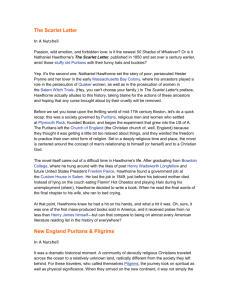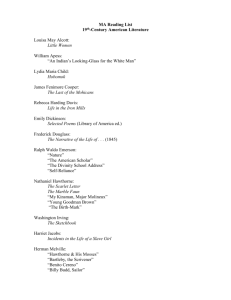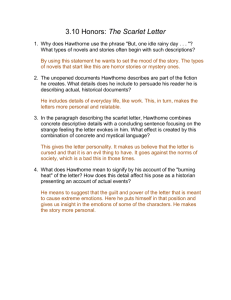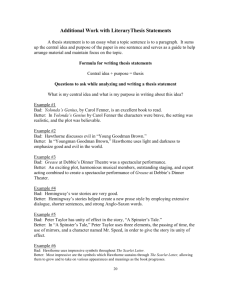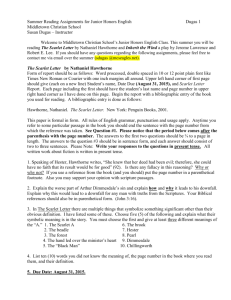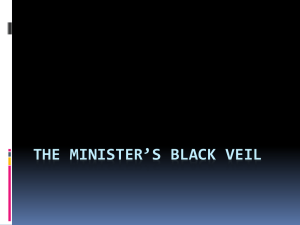Nathaniel Hawthorne (1804
advertisement
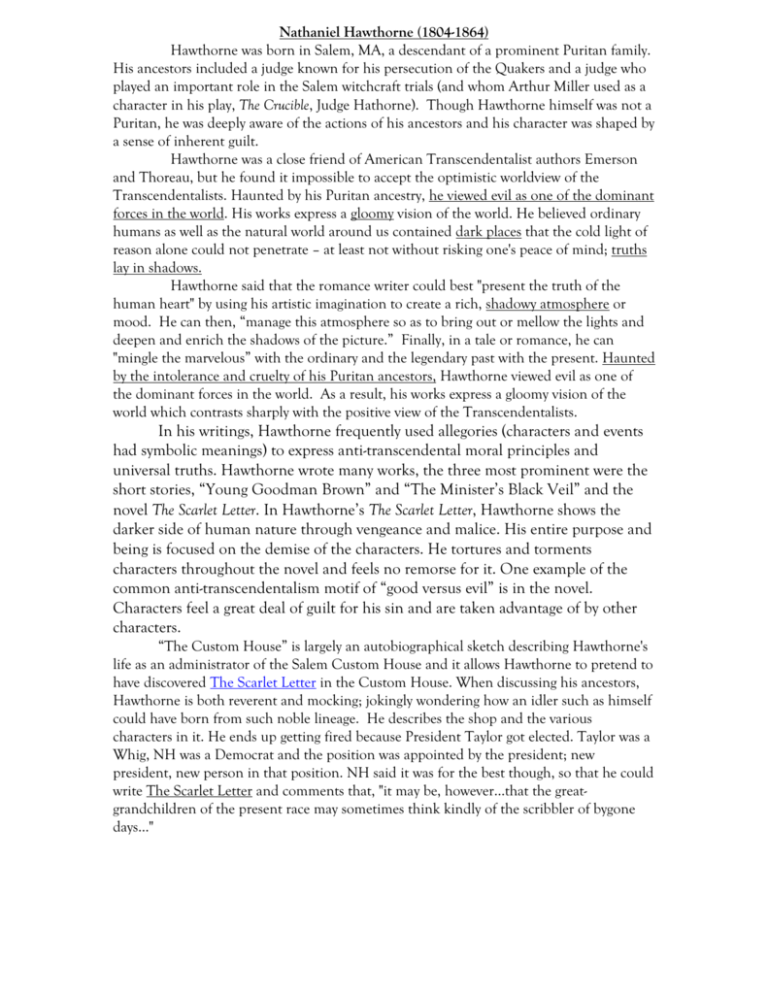
Nathaniel Hawthorne (1804-1864) Hawthorne was born in Salem, MA, a descendant of a prominent Puritan family. His ancestors included a judge known for his persecution of the Quakers and a judge who played an important role in the Salem witchcraft trials (and whom Arthur Miller used as a character in his play, The Crucible, Judge Hathorne). Though Hawthorne himself was not a Puritan, he was deeply aware of the actions of his ancestors and his character was shaped by a sense of inherent guilt. Hawthorne was a close friend of American Transcendentalist authors Emerson and Thoreau, but he found it impossible to accept the optimistic worldview of the Transcendentalists. Haunted by his Puritan ancestry, he viewed evil as one of the dominant forces in the world. His works express a gloomy vision of the world. He believed ordinary humans as well as the natural world around us contained dark places that the cold light of reason alone could not penetrate – at least not without risking one's peace of mind; truths lay in shadows. Hawthorne said that the romance writer could best "present the truth of the human heart" by using his artistic imagination to create a rich, shadowy atmosphere or mood. He can then, “manage this atmosphere so as to bring out or mellow the lights and deepen and enrich the shadows of the picture.” Finally, in a tale or romance, he can "mingle the marvelous” with the ordinary and the legendary past with the present. Haunted by the intolerance and cruelty of his Puritan ancestors, Hawthorne viewed evil as one of the dominant forces in the world. As a result, his works express a gloomy vision of the world which contrasts sharply with the positive view of the Transcendentalists. In his writings, Hawthorne frequently used allegories (characters and events had symbolic meanings) to express anti-transcendental moral principles and universal truths. Hawthorne wrote many works, the three most prominent were the short stories, “Young Goodman Brown” and “The Minister’s Black Veil” and the novel The Scarlet Letter. In Hawthorne’s The Scarlet Letter, Hawthorne shows the darker side of human nature through vengeance and malice. His entire purpose and being is focused on the demise of the characters. He tortures and torments characters throughout the novel and feels no remorse for it. One example of the common anti-transcendentalism motif of “good versus evil” is in the novel. Characters feel a great deal of guilt for his sin and are taken advantage of by other characters. “The Custom House” is largely an autobiographical sketch describing Hawthorne's life as an administrator of the Salem Custom House and it allows Hawthorne to pretend to have discovered The Scarlet Letter in the Custom House. When discussing his ancestors, Hawthorne is both reverent and mocking; jokingly wondering how an idler such as himself could have born from such noble lineage. He describes the shop and the various characters in it. He ends up getting fired because President Taylor got elected. Taylor was a Whig, NH was a Democrat and the position was appointed by the president; new president, new person in that position. NH said it was for the best though, so that he could write The Scarlet Letter and comments that, "it may be, however...that the greatgrandchildren of the present race may sometimes think kindly of the scribbler of bygone days..." Anti-Transcendentalism To oppose transcendentalism, it is a belief that humans at their core are inherently evil and will consistently behave in a manner sympathetic to their sinful ambitions. As is clear in its name, anti-transcendentalism contrasts transcendentalism by focusing on the darkness of the human soul. Anti-transcendentalists felt that the transcendental point of view was too optimistic, and it overlooked the evil that plagued man. They had dark and disturbing visions of human life and behavior. Hawthorne, along with Herman Melville who wrote Moby Dick, is clearly an anti-transcendentalist. Evil Six anti-transcendentalist characteristics Guilt Human Limitations Nature as evil Battle (internal and external) Mystery Name: Creative Title: Given all of this information about Hawthorne, in a well-written essay that has a solid structure, write a third person answer to the following question (even though there are a few questions, they are all basically asking the same thing): How does The Scarlet Letter reflect Hawthorne’s values? What was Hawthorne trying to say about his heritage and beliefs in his text? How is The Scarlet Letter a true reflection of Anti-transcendentalism? What Hawthorne-esque attitudes are represented in The Scarlet Letter? ________/10 Essay has a solid structure, uses transitional phrases effectively and works to prove a clear thesis. ________/10 Essay is free of the writing errors that we discussed in class and is a shining example of honors 11 quality authorship. ________/10 The essay’s ideas are thoughtful, thoroughly developed, ample and accurately work to convince the reader that the thesis is true. ________/30 Total Brainstorm ideas below and staple this sheet with your name showing as the cover page of your essay. Double space, hand write this essay, only write in the fronts and spend no more than an hour writing this essay.
